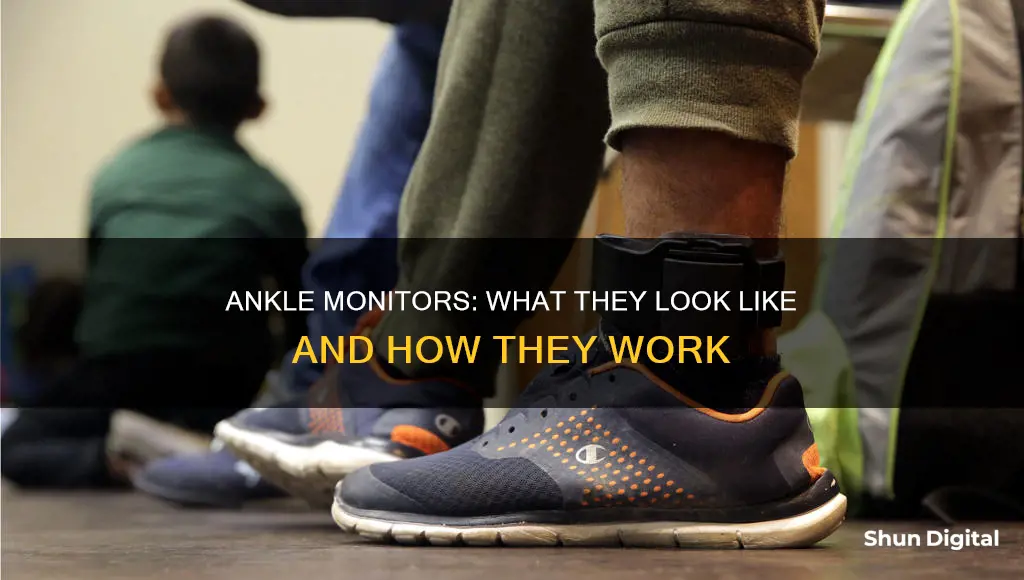
Ankle monitors are electronic devices used to track an individual's location and movements. They are typically worn by people who are awaiting trial, on probation or parole, or facing immigration proceedings. The device is secured around the ankle with a strap and uses GPS technology to record the wearer's location. Ankle monitors are often referred to as ankle bracelets, shackles, or tethers, and they are used as an alternative to incarceration to restrict an individual's movements and limit how long they can stay outside. They are equipped with anti-tampering technology and can detect attempts to remove or interfere with the device. The use of ankle monitors has been controversial, with critics arguing that they fail to meet their intended goals, contribute to mass incarceration, and exacerbate systemic inequities.
| Characteristics | Values |
|---|---|
| Type of device | Ankle bracelet, ankle shackle, or tether |
| Purpose | Record the location of wearers |
| Wearers | People awaiting trial, serving probation and parole, and facing immigration proceedings |
| Features | GPS tracking system |
| Use | Limit how long a person can stay outside and where they can go |
| Cost | $3-$35 a day, with initial setup charges ranging from $100 to $200 |
| Alcohol monitoring | SCRAM CAM bracelet provides 24/7 transdermal alcohol testing |
| Alcohol monitoring features | Samples the wearer's perspiration every 30 minutes |
| Alcohol monitoring benefits | Supports sobriety and increases compliance with court orders |
| Installation | Easy to fit to any ankle |
| Strap | Hypo-allergenic soft rubber strap |
| Security | Robust tamper clip |
| Alert | If the device has been tampered with |
What You'll Learn
- Ankle monitors are used for electronic surveillance
- They are used by people awaiting trial, serving probation and parole, and facing immigration proceedings
- Ankle monitors can be used to monitor alcohol consumption
- They can be used to track location
- Ankle monitors are also known as ankle bracelets, ankle shackles, or tethers

Ankle monitors are used for electronic surveillance
The ankle monitor is a form of digital incarceration, known as e-carceration, which has seen a significant rise in usage. From 2005 to 2015, the number of active electronic monitors in use increased by 140%. Despite their widespread adoption, studies have questioned the effectiveness of ankle monitors in achieving their stated goals of ensuring court appearances, protecting public safety, and facilitating rehabilitation. Instead, these devices have been criticised for contributing to mass incarceration, as minor technical violations, charging malfunctions, and false alarms can lead individuals back to physical jails and prisons.
Ankle monitors have also been criticised for exacerbating systemic inequities, particularly along lines of race, class, and disability. For example, in Detroit, there is a significant disparity, with Black individuals being twice as likely as white individuals to be subjected to electronic monitoring. Additionally, the financial burden associated with these devices can be significant, with daily fees ranging from $3 to $35, along with initial setup charges that can reach up to $200. These expenses can pose a substantial challenge for households already facing the economic impact of a family member's incarceration.
Furthermore, the stigma, social isolation, and stress associated with being monitored can have detrimental effects on the mental health of wearers, exacerbating depression and anxiety. The restrictions on movement and the constant surveillance can create significant obstacles to individuals' efforts to reintegrate into society, affecting their ability to work, attend school, or engage in social activities. As a result, some individuals may resort to drastic measures, such as attempting to remove the monitor or even considering self-harm to escape the constant monitoring.
Choosing the Right Monitor Size for Security Cameras
You may want to see also

They are used by people awaiting trial, serving probation and parole, and facing immigration proceedings
Ankle monitors are electronic surveillance devices that use GPS tracking systems to record the location of their wearers. They are typically referred to as ankle bracelets, ankle shackles, or tethers. These devices are worn by individuals who are either awaiting trial, serving probation or parole, or facing immigration proceedings. The use of electronic monitoring allows jurisdictions to restrict an individual's movements, including how long they can stay outside and the places they can visit.
For those awaiting trial, ankle monitors provide a way to ensure their presence at court appearances. By wearing these devices, individuals can remain out of jail while awaiting their court dates. However, any violations of the set conditions, such as tampering with the device or leaving designated areas, can result in further legal consequences.
For individuals serving probation or parole, ankle monitors serve as a condition of their release. They provide an alternative to physical incarceration, allowing individuals to reintegrate into society while still being monitored. Parole officers can track the movements of those on parole and ensure they are adhering to the conditions of their release.
In the context of immigration proceedings, ankle monitors are used to track the whereabouts of individuals who may be facing deportation or other legal processes. This allows authorities to enforce restrictions on their movements and ensure compliance with court orders.
While ankle monitors offer an alternative to physical incarceration, they have also been criticised for their potential to stigmatise and harm those who wear them. The devices can lead to social isolation, stress, and financial burdens, particularly for those from marginalised communities. Additionally, the use of electronic monitoring has been associated with the expansion of mass incarceration, as minor technical violations can result in individuals being sent back to physical jails or prisons.
The Ultimate Guide to Buying 17-Inch Monitors
You may want to see also

Ankle monitors can be used to monitor alcohol consumption
Ankle monitors are typically used to track the location of the wearer, and they are often referred to as ankle bracelets, shackles, or tethers. They are usually used on people who are awaiting trial, on probation or parole, or facing immigration proceedings. However, ankle monitors can also be used to monitor alcohol consumption. These are known as SCRAM bracelets (Secure Continuous Remote Alcohol Monitoring).
SCRAM bracelets are fitted to the ankle and can detect the presence of alcohol in the wearer's perspiration. They are often used for those who have been convicted of driving while intoxicated (DWI) or driving under the influence (DUI). The bracelets can test for alcohol every 30 minutes, providing detailed information on alcohol consumption over a specific period. This information can then be used in a legal setting, such as for court orders to refrain from drinking.
The use of SCRAM bracelets offers several benefits. Firstly, they eliminate the need for frequent in-person check-ins to test for alcohol use. Secondly, they provide continuous alcohol monitoring, which has been proven to support long-term behaviour change and reduce the risk of reoffending when combined with alcohol treatment. Additionally, SCRAM bracelets can distinguish between alcohol consumption and exposure to external environmental sources of alcohol, such as alcohol-based mouthwash or hand sanitiser.
While SCRAM bracelets are useful for monitoring alcohol consumption, they cannot confirm complete abstinence from alcohol. However, even low levels of alcohol consumption (1-2 units) can be detected by the bracelet. In addition, SCRAM bracelets have temperature and infrared sensors that can detect any attempts to tamper with or obstruct the device. This information can be transmitted wirelessly to a Base Station, which then sends the data to a monitoring centre. If the wearer's alcohol consumption exceeds the allowed limit or if the bracelet is tampered with, the monitoring centre will contact the appropriate authorities.
Best Places to Buy High-Quality Monitors: A Comprehensive Guide
You may want to see also

They can be used to track location
Ankle monitors are electronic surveillance devices that can be used to track an individual's location. They are typically worn around the ankle, as the name suggests, and may be referred to as ankle bracelets, ankle shackles, or tethers. These monitors employ GPS tracking systems to record the wearer's whereabouts, allowing authorities to enforce restrictions on how long an individual can stay outside and the places they can visit.
The use of ankle monitors for location tracking has seen a significant increase. From 2005 to 2015, the number of active electronic monitors in use rose by 140%. Ankle monitors are often employed as an alternative to incarceration, particularly during the COVID-19 pandemic, to reduce the risk of disease transmission in crowded prisons and jails. This form of electronic surveillance, also known as e-carceration, provides authorities with the ability to monitor individuals awaiting trial, serving probation or parole, or facing immigration proceedings.
The tracking technology integrated into ankle monitors enables authorities to enforce specific conditions on individuals under supervision. For example, they can restrict the amount of time a person spends outside or designate approved locations they are permitted to visit. This level of surveillance can significantly impact the wearer's daily life, as they must navigate the complexities of work, education, and social activities while adhering to the constraints of their monitoring device.
Ankle monitors also come with associated fees, which can pose a financial burden on individuals and their families. These fees, ranging from $3 to $35 per day, are often in addition to initial setup charges that can reach $100 to $200. The cumulative cost of these charges can amount to hundreds of dollars per month, creating economic challenges for households already dealing with the aftermath of incarceration.
While ankle monitors are intended to ensure court appearances, protect public safety, and promote rehabilitation, their effectiveness in achieving these goals has been questioned. Studies indicate that electronic monitoring may contribute to mass incarceration, leading to physical jails and prisons for minor technical violations, charging malfunctions, and false alarms. Additionally, the stigma, social isolation, and stress associated with being monitored can exacerbate mental health issues such as depression and anxiety for the wearers.
Asus Monitor Warranty: Lifetime Promise or Limited Offer?
You may want to see also

Ankle monitors are also known as ankle bracelets, ankle shackles, or tethers
The devices are worn around the ankle, with a strap that is adjusted to fit securely. They are designed to be unobtrusive, but also difficult to remove without detection. The most popular models have a fibre optic cable that runs through the strap, and any attempt to tamper with or cut the strap will trigger an alert. The monitors also have anti-tamper technology that identifies circumvention attempts.
In addition to tracking location, ankle monitors can also be equipped with other features such as alcohol monitoring. For example, the SCRAM CAM® bracelet provides 24/7 transdermal alcohol testing for drunk drivers, high-risk alcohol cases, and domestic violence offenders. It samples the wearer's perspiration every 30 minutes to encourage sobriety and compliance with court orders.
The use of ankle monitors has been controversial due to concerns about their effectiveness, impact on civil liberties, and potential to exacerbate systemic inequities. Studies have shown that monitors may fail to meet their stated goals of ensuring court appearances, protecting public safety, and promoting rehabilitation. Instead, they can lead to further incarceration for minor technical violations and false alarms, contributing to the problem of mass incarceration.
Furthermore, the fees associated with wearing an ankle monitor can be burdensome, ranging from $3 to $35 per day, with additional setup charges. This can create financial strain, particularly for households already dealing with the return of a family member from incarceration. The stigma, social isolation, and stress associated with being monitored can also negatively impact the mental health of wearers.
The Evolution of Standard Monitor Sizes
You may want to see also
Frequently asked questions
Ankle monitors are typically referred to as ankle bracelets, shackles, or tethers. They are worn around the ankle and are designed to be unobtrusive and difficult to remove. The monitors are equipped with GPS tracking systems and anti-tampering technology.
Ankle monitors are worn by people who are awaiting trial, serving probation or parole, or facing immigration proceedings. They are also used for alcohol monitoring, with some monitors, like the SCRAM CAM, providing 24/7 transdermal alcohol testing.
Ankle monitors use GPS technology to track the location of the wearer. This information is transmitted to a monitoring software or app, allowing authorities to track the wearer's movements. Some monitors also have the ability to detect alcohol consumption through the wearer's perspiration.
It is very difficult to remove an ankle monitor without triggering an alert. All ankle monitors have built-in anti-tampering technology, such as fiber optic cables or electrochemical fuel cells, that detect any attempts to remove or interfere with the device.







